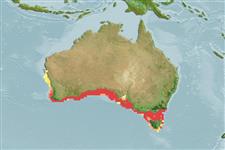>
Eupercaria/misc (Various families in series Eupercaria) >
Gerreidae (Mojarras)
Etymology: Parequula: Latin, par = two + Latin, aequus, aequalis = equal (Ref. 45335).
More on author: Castelnau.
Environment: milieu / climate zone / depth range / distribution range
Écologie
marin démersal; profondeur 3 - 100 m (Ref. 9563). Temperate; 26°S - 45°S, 112°E - 150°E
Eastern Indian Ocean: southern Australia, from southern Western Australia to Victoria, including Tasmania.
Taille / Poids / Âge
Maturity: Lm ? range ? - ? cm
Max length : 22.0 cm TL mâle / non sexé; (Ref. 26068)
Description synthétique
Clés d'identification | Morphologie | Morphométrie
Épines dorsales (Total) : 9 - 11; Rayons mous dorsaux (Total) : 17 - 18; Épines anales: 3; Rayons mous anaux: 17 - 18.
Occurs on the continental shelf (Ref. 9563), over sand and seagrass (Ref. 26068).
Life cycle and mating behavior
Maturité | Reproduction | Frai | Œufs | Fécondité | Larves
Iwatsuki, Y., J.J. Pogonoski and P. Last, 2012. Revision of the genus Parequula (Pisces: Gerreidae) with a new species from southwestern Australia. Zootaxa 3425:42-54. (Ref. 93115)
Statut dans la liste rouge de l'IUCN (Ref. 130435: Version 2024-1)
Menace pour l'homme
Harmless
Utilisations par l'homme
Pêcheries:
Outils
Articles particuliers
Télécharger en XML
Sources Internet
Estimates based on models
Preferred temperature (Ref.
123201): 14.7 - 20.1, mean 17.2 °C (based on 222 cells).
Phylogenetic diversity index (Ref.
82804): PD
50 = 0.7500 [Uniqueness, from 0.5 = low to 2.0 = high].
Bayesian length-weight: a=0.01413 (0.00635 - 0.03140), b=3.04 (2.86 - 3.22), in cm total length, based on LWR estimates for this (Sub)family-body shape (Ref.
93245).
Niveau trophique (Ref.
69278): 3.5 ±0.2 se; based on diet studies.
Résilience (Ref.
120179): Haut, temps minimum de doublement de population inférieur à 15 mois (Preliminary K or Fecundity.).
Fishing Vulnerability (Ref.
59153): Low vulnerability (12 of 100).
Nutrients (Ref.
124155): Calcium = 66.5 [31.0, 129.0] mg/100g; Iron = 0.422 [0.200, 0.877] mg/100g; Protein = 18.3 [16.3, 20.3] %; Omega3 = 0.544 [0.256, 1.079] g/100g; Selenium = 12.6 [6.1, 27.7] μg/100g; VitaminA = 9.47 [1.97, 41.60] μg/100g; Zinc = 0.562 [0.364, 0.881] mg/100g (wet weight);
